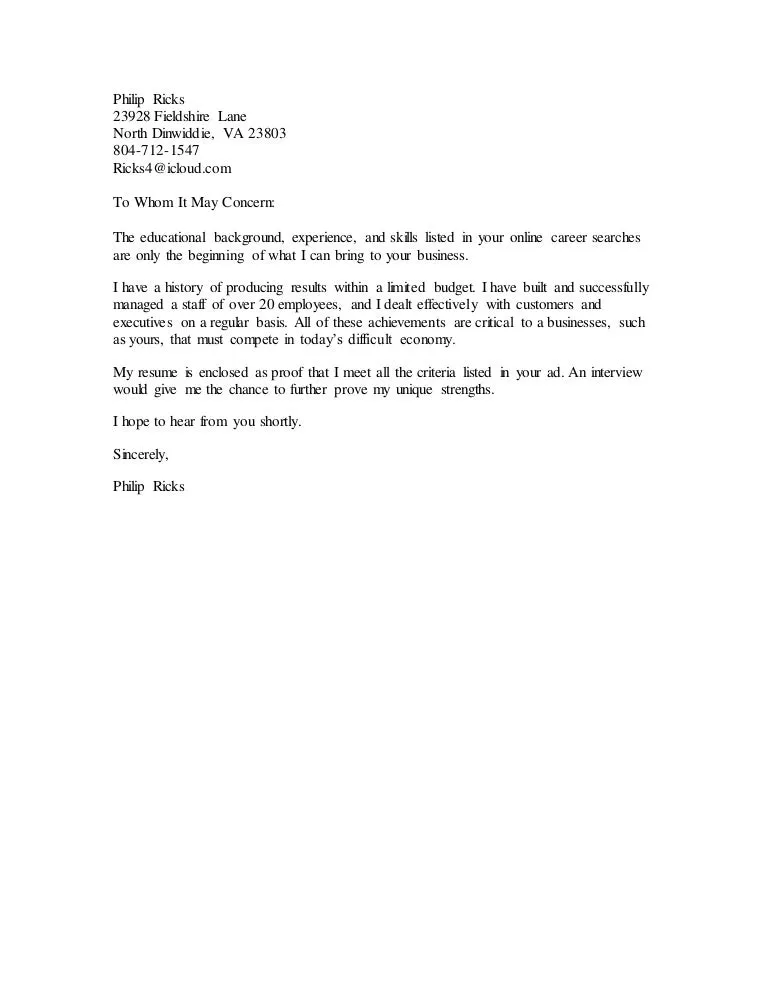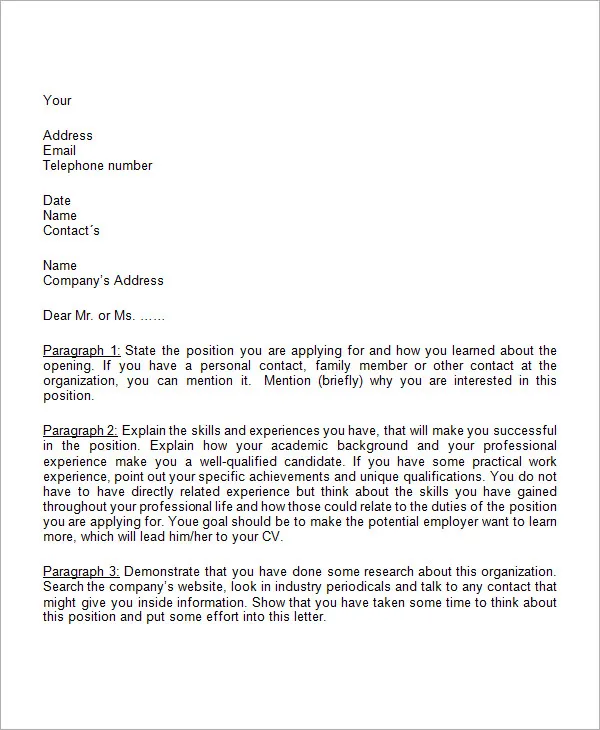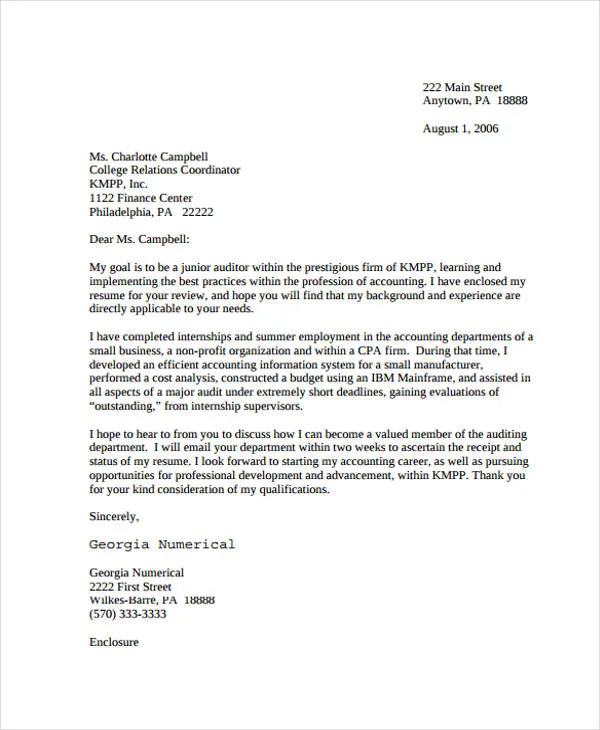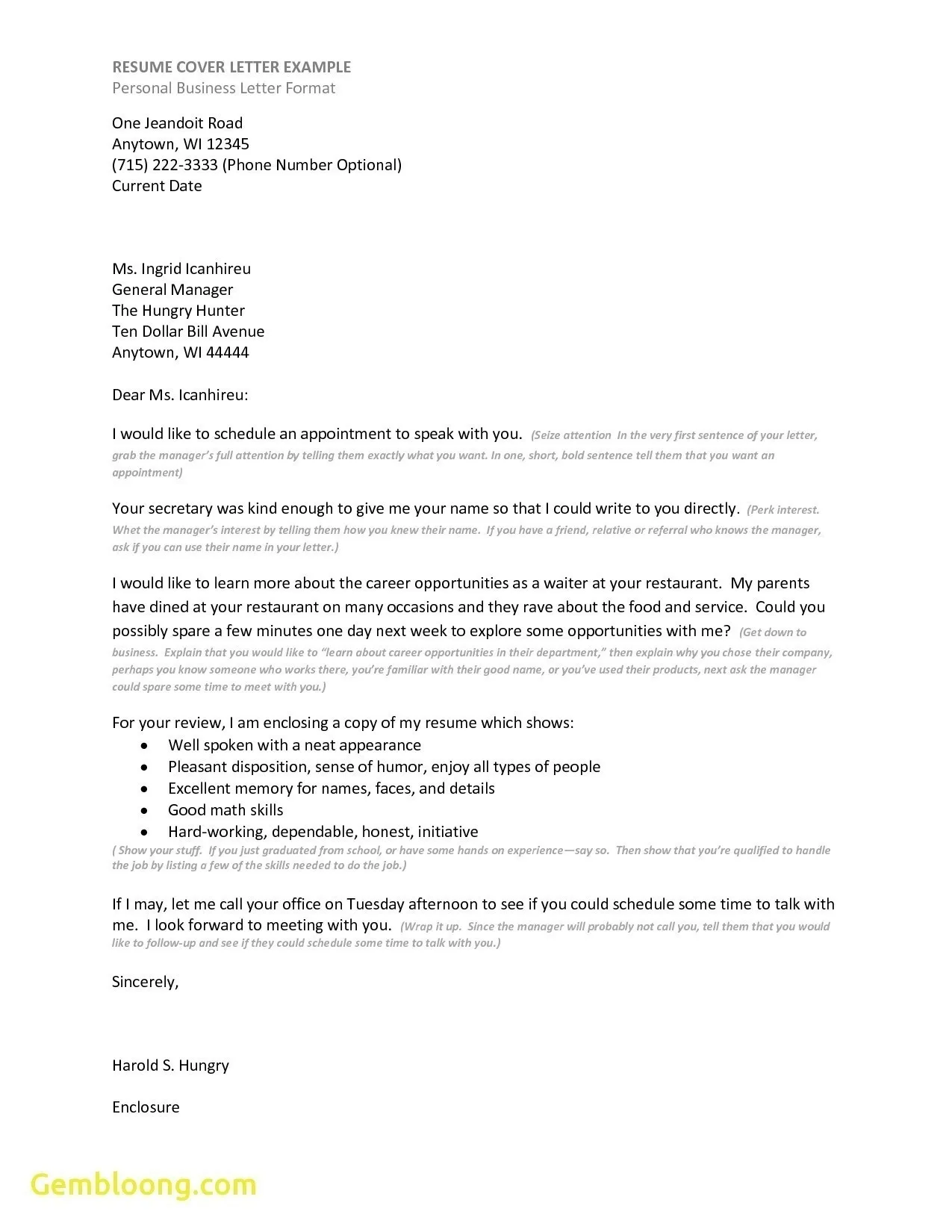What is a Business Cover Letter
A business cover letter is a formal document that accompanies your resume when applying for a job. It serves as your first introduction to a potential employer, providing an opportunity to express your interest in the position, highlight relevant skills and experience, and demonstrate your understanding of the company and the role. Unlike a resume, which offers a factual summary of your background, a cover letter allows you to personalize your application and showcase your personality, communication skills, and enthusiasm. It’s a crucial tool for making a strong first impression and increasing your chances of getting an interview. A well-crafted cover letter can set you apart from other candidates and make a compelling case for why you’re the best fit for the job.
Why Is a Business Cover Letter Important
The importance of a business cover letter cannot be overstated in the job application process. Firstly, it provides context to your resume, allowing you to explain your career goals and how your skills align with the specific job requirements. Secondly, it offers a space to elaborate on your accomplishments and experiences, providing specific examples that demonstrate your value to a potential employer. Thirdly, a cover letter showcases your communication skills, attention to detail, and professionalism, all of which are essential qualities in the workplace. Moreover, it allows you to demonstrate your genuine interest in the company and the position, showing that you’ve done your research and are not just sending out generic applications. Lastly, in a competitive job market, a well-written cover letter can be the differentiating factor that lands you an interview. This is why cover letters are more than just a formality they are a strategic opportunity to make a strong, lasting impression.
Key Elements of a Business Cover Letter

A compelling business cover letter comprises several key elements. These components work together to create a cohesive narrative that captures the hiring manager’s attention and effectively conveys your qualifications. First, your contact information ensures the employer can easily reach you. Second, a clear date and the recipient’s details demonstrate professionalism. Third, a proper salutation using the recipient’s name makes a personal connection. Fourth, the opening paragraph should capture attention immediately, stating the position and your interest. Fifth, highlight relevant skills and experiences. Sixth, showcase your value and quantify accomplishments. Seventh, address the company’s specific needs by showing how you can contribute. Eighth, strategically use keywords from the job description. Ninth, follow formatting and style guidelines to maintain a polished appearance. Finally, include a clear call to action, prompting the employer to contact you.
Your Contact Information
Your contact information should be the first section of your cover letter, clearly displayed at the top. Include your full name, professional email address, phone number, and optionally, your LinkedIn profile URL. Ensure your email address sounds professional and is easily readable. Double-check all information for accuracy, as even a small error could prevent the employer from contacting you. Keeping your contact details concise and prominent ensures easy access to your information, making it simple for the hiring manager to connect with you. This section is the foundation for any communication so accuracy and professionalism here are key to create a positive first impression and facilitate seamless contact.
Date and Recipient Details
Following your contact information, include the date of the letter. This date is important for record-keeping. Then, provide the recipient’s details, including the hiring manager’s name (if known), job title, the company’s name, and the company’s address. If you are unsure of the hiring manager’s name, research the company’s website or LinkedIn to find it. Use a formal tone when addressing the recipient, such as ‘Mr.’ or ‘Ms.’ followed by their last name. Accurate details demonstrate your attention to detail and respect for the employer. If the specific hiring manager’s name isn’t available, address the letter to the ‘Hiring Manager’ or the ‘Human Resources Department’. This shows you’ve made an effort to personalize your application, even in the absence of specific information.
Salutation [How to Address the Recipient]

The salutation sets the tone for your cover letter. If you know the hiring manager’s name, use a personal greeting like ‘Dear Mr. Smith’ or ‘Dear Ms. Jones’. This immediately establishes a connection and makes your letter feel more personal. If the name is unavailable, use a professional alternative such as ‘Dear Hiring Manager’ or ‘Dear Human Resources Department’. Avoid generic greetings such as ‘To Whom It May Concern’, as they lack personalization. Ensure you use the correct title (Mr., Ms., Dr., etc.) to show respect. Keep the tone professional and formal, maintaining the decorum appropriate for a business context. A well-chosen salutation shows that you are detail-oriented and respectful, setting a positive tone for the rest of your cover letter.
The Opening Paragraph [Grab Their Attention]
Your opening paragraph is crucial for grabbing the hiring manager’s attention. Start by stating the position you’re applying for and where you saw the job posting. Briefly mention your enthusiasm for the role and the company. Highlight something specific that made you interested in the position, such as a specific project or the company’s values. Avoid generic statements. Instead, use this opportunity to make a strong first impression by showing that you’ve researched the company and understand the role. Ensure your opening is concise and engaging to capture immediate interest. This paragraph sets the stage for the rest of your letter, making it a key element in successfully getting your application noticed.
Highlight Your Skills and Experience
The core of your cover letter should highlight your skills and experience relevant to the job requirements. Review the job description carefully and identify the key skills and qualifications the employer is seeking. Then, provide specific examples from your past experiences that demonstrate how you meet these requirements. Quantify your achievements whenever possible using numbers and data to show the impact of your work. For example, instead of saying ‘Managed social media campaigns,’ write ‘Increased social media engagement by 30% in six months.’ Tailor the information to match the specific needs of the job. By focusing on relevant skills and using concrete examples, you will effectively convince the employer of your capabilities and value as a potential employee. Focus on your most impressive accomplishments that directly align with the job requirements, making a strong case for your candidacy.
Showcase Your Value

Showcasing your value goes beyond listing your skills; it’s about demonstrating how you can contribute to the company’s goals. Explain how your skills and experiences align with the company’s mission and objectives. Research the company to understand its challenges and opportunities, and then explain how you can help address these. Use specific examples to show how you’ve added value in past roles. Highlight achievements that showcase your ability to solve problems, improve processes, or generate positive results. Demonstrate your understanding of the industry and the role, and connect your contributions to the company’s success. Clearly articulating your value and linking it to the company’s objectives makes your cover letter more compelling and increases your chances of securing an interview.
Address the Company’s Needs
To address the company’s needs effectively, tailor your cover letter to show that you understand their specific requirements and challenges. Research the company thoroughly to identify their goals, values, and current projects. Analyze the job description carefully to understand the role’s responsibilities and the skills needed. In your cover letter, explain how your skills and experiences align with these needs and how you can contribute to their success. Provide examples of how you have solved similar problems or achieved comparable results in the past. By demonstrating that you understand the company’s priorities and can provide solutions, you make a strong case for your suitability for the position. Customize your letter to the specific company and position, making it clear you’re not just sending a generic application but are genuinely interested in the role and its contribution.
Use Keywords
Keywords are essential in modern job applications because many companies use Applicant Tracking Systems (ATS) to screen resumes and cover letters. To effectively use keywords, carefully review the job description and identify the specific skills, qualifications, and phrases. Integrate these keywords naturally into your cover letter, particularly in the skills and experience sections. Avoid keyword stuffing, which can make your letter sound unnatural and be easily detected by the ATS. Focus on incorporating relevant keywords strategically. Use the same language as the job description to maximize your chances of passing the initial screening. By including the right keywords, you increase your visibility and ensure your application is noticed by the hiring manager.
Formatting and Style

Formatting and style are critical for creating a professional cover letter. Maintain a clean and consistent format, ensuring your letter is easy to read. Use a standard business letter format with clear headings, paragraphs, and spacing. Choose a professional font such as Times New Roman, Arial, or Calibri, with a font size between 10 and 12 points for readability. Use single spacing within paragraphs and double spacing between paragraphs. Use concise language and avoid overly complex sentences. Maintain a formal and professional tone throughout your letter. Be mindful of the language you use, and tailor it to the company’s culture and the specific role. Pay attention to detail, ensuring your cover letter looks polished and professional. Proper formatting and style enhance the overall impact of your application.
Professional Tone and Language
Maintaining a professional tone and using appropriate language is crucial for a business cover letter. Avoid using slang, jargon, or casual language that might be used in informal communication. Your language should be clear, concise, and respectful. Proofread your letter carefully to eliminate any grammatical errors, typos, or spelling mistakes, as these can undermine your credibility. Use positive and confident language to showcase your skills and accomplishments. Avoid being overly assertive or demanding. Tailor your language to the company’s culture and the specific role, showing that you understand the professional environment you are applying to. This creates a positive first impression and demonstrates your attention to detail and communication skills. Professional language ensures your cover letter is taken seriously and reflects your qualifications.
Font Choice and Readability
The font choice significantly impacts your cover letter’s readability and professionalism. Choose a standard and easily readable font, such as Times New Roman, Arial, Calibri, or Helvetica. These fonts are widely recognized and are designed to be clear and easy on the eyes. Stick to a font size between 10 and 12 points, making sure the text is neither too small nor too large. The font style must match the tone of your letter. Use a consistent font throughout the entire document for a polished look. Readability is critical, so use a font that is easy to read on both screen and paper. A well-chosen font choice demonstrates your attention to detail and ensures that the hiring manager can easily read and comprehend your cover letter.
Proofread and Edit

Proofreading and editing are essential steps in writing a business cover letter. Before submitting your application, meticulously proofread your letter for any grammatical errors, typos, spelling mistakes, and punctuation errors. Read the letter multiple times, preferably with a fresh pair of eyes, or ask a friend, colleague, or family member to review it. Pay close attention to sentence structure, clarity, and flow. Ensure that the information you’ve provided is accurate and consistent with your resume. Double-check all names, titles, dates, and contact details. Correcting any errors can prevent negative first impressions and demonstrate your attention to detail and professionalism. It shows that you’ve taken the time and care to present your best self. Proofreading improves your credibility and enhances your overall application.
Formatting Guidelines
Adhering to formatting guidelines is crucial for a professional business cover letter. Use standard business letter format, which includes your contact information, date, recipient details, salutation, body paragraphs, closing, and signature. Use a formal font style such as Times New Roman, Arial, or Calibri. Set your margins to 1 inch on all sides to create a clean look. Use single-spacing within paragraphs and double-spacing between paragraphs for better readability. Align your text to the left, avoiding justification, as it can cause inconsistent spacing. Keep the letter concise, ideally no more than one page in length. Following these guidelines makes your cover letter easy to read and presents a polished, professional image, demonstrating your attention to detail.
Use a Template
Using a template can streamline the process of writing a business cover letter. Templates provide a pre-formatted structure that includes all the necessary elements. They ensure that you don’t miss any important parts of the cover letter, such as your contact information, salutation, body paragraphs, and closing. Templates are available from various sources, including Microsoft Word, Google Docs, and online resources. Choose a template that fits your needs and the style that you want to present. However, always customize the template. Fill it with your specific information, skills, and experiences. Ensure the template is appropriate for the role and the company you are applying to. Using a template as a starting point can save time and ensure your cover letter looks professional, allowing you to focus on the content rather than the format.
Customize for Each Application

Customizing your cover letter for each application is essential for demonstrating your interest and suitability. Avoid using a generic cover letter for all job applications. Instead, research the company and the specific role to understand the requirements and the company’s values. Tailor your letter to the specific needs of the job description, highlighting the skills and experiences that align with the requirements. Address the hiring manager by name whenever possible and show how you can contribute to the company’s goals. Mention any specific projects, values, or aspects of the company that appeal to you. Personalized cover letters show that you’ve taken the time to understand the role and that you genuinely want to join the company. This significantly increases your chances of getting noticed and making a strong impression.
Call to Action
The call to action is the closing element where you prompt the reader to take a specific action. In your cover letter, clearly state your interest in an interview and make it easy for the employer to contact you. Express your enthusiasm for the role and the company and reiterate your skills and qualifications. Provide your contact information again, including your email and phone number. Thank the hiring manager for their time and consideration. Make sure your closing is confident and professional. For example, you might say: ‘I am eager to discuss how my skills can benefit your team. I am available for an interview at your earliest convenience. Thank you for your consideration.’ A strong call to action shows your interest and encourages the hiring manager to respond.
Closing and Signature
Your closing and signature complete your business cover letter. Use a professional closing such as ‘Sincerely,’ ‘Best regards,’ or ‘Yours sincerely.’ Avoid informal closings. Leave a space for your signature above your typed name. If submitting a digital document, you can either scan your handwritten signature or use an electronic signature. Type your full name below the closing. Ensure your closing aligns with the overall tone and formality of the letter. The closing is another opportunity to convey professionalism, leaving a lasting positive impression on the hiring manager. This final touch demonstrates that you pay attention to all the details and finish strong. This reinforces your professionalism and sets a great tone for potential future communications.
Example of a Business Cover Letter
Here is an example of a well-structured business cover letter to guide you. (Your Name) (Your Address) (Your Phone) (Your Email) (Date) (Hiring Manager Name or Title) (Company Name) (Company Address) Dear (Mr./Ms. Last Name), I am writing to express my keen interest in the Marketing Manager position at [Company Name], as advertised on [Platform]. With over five years of experience in marketing and a proven track record of driving successful campaigns, I am confident I can significantly contribute to your team. In my previous role at [Previous Company], I was responsible for (specific achievements) which resulted in (measurable results). I am particularly drawn to [Company Name]’s commitment to [company value] and believe my skills in [relevant skills] align perfectly with your goals. I have attached my resume for your review and welcome the opportunity to discuss my qualifications in more detail. Thank you for your time and consideration. Sincerely, (Your Signature) (Your Typed Name). You should adjust this example based on your own situation. By using this example as a guide, you can confidently write a compelling business cover letter.
